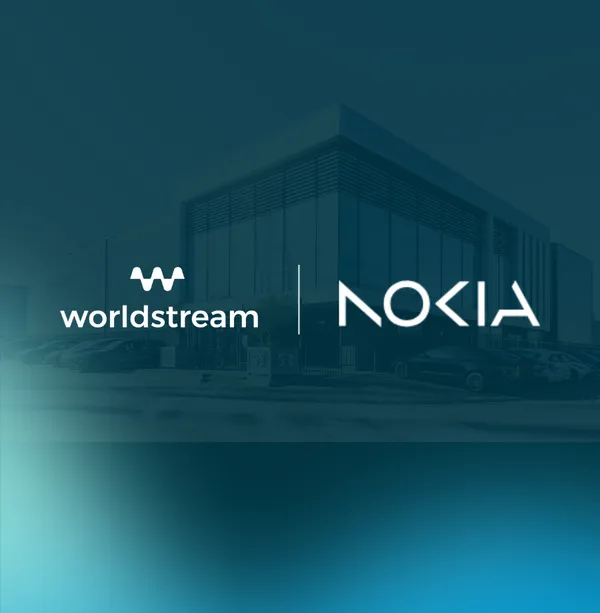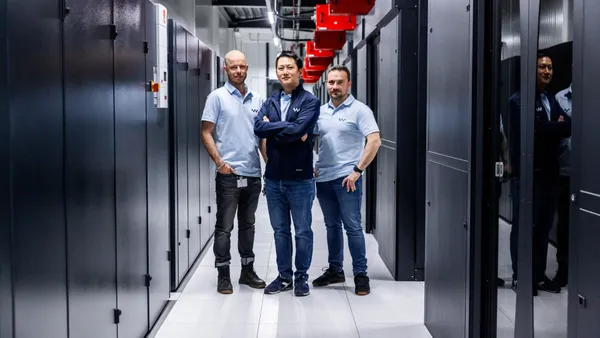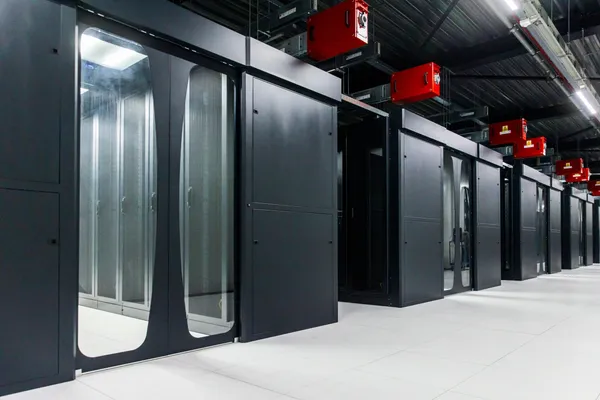The cloud is not serverless, in search of a better definition

Knowledge blog

Today, the cloud seems to be a catch-all term for all shared compute resources that can be utilized without any third-party intervention. Requesting resources in real-time so that it is acutely available to the end user. For many this is still an abstract concept, you might wonder if this term fits the concept. But how do you decide what would be a better name? Let’s make an attempt by assessing the origin of the term. Then subsequently answering the question: is there a better term than cloud?
Where did the term cloud come from anyway?
The very first programmable computer (Colossus) was about as big as today’s average student apartment. Maybe just as expensive. In the 1960s, NASA used the IBM 7094 for software development and the Apollo space program. There wasn’t an abundance of programming languages back then. You wrote software in assembly, and that was it. You could even say that thanks to NASA and IBM, it became possible to literally send data into the air. Or rather, into space. Is there perhaps some truth in this explanation for the origin of the term cloud? Possibly, although this is only one of the many explanations for where the term cloud originated from.
Historically, cloud computing originated from time-sharing, where compute resources were shared between users. With time-sharing we are referring to a computing technology where multiple users can access a computer at the same time. A revolutionary idea, in the 1950s, where only large companies were able to afford these very expensive machines. Time-sharing gave smaller organizations the ability to use that same technology. Time-sharing has a shared characteristic with cloud computing, namely to abstract users from the physical interaction with computers and servers. However, this does not bring us to the point of determining whether the term cloud needs renewal.
The most plausible explanation is that the term found its way into IT from telecommunications. Historically telecommunications diagrams depicted all unknown connections – anything outside one’s own network – as clouds. Thus, the cloud gradually found its way into the description of the Internet. Which is why we see the same phenomenon on the original diagrams of ARPANET. Where the cloud drawings symbolized components, as with telecommunications, that were further away from its direct sphere of influence. And thus, again, a form of abstraction.
Clearly, there are numerous explanations for how the term cloud has become commonplace in the IT world. Perhaps the modern understanding of what cloud computing is gives an answer to our question. Some link parties like Google or Amazon to its success, while others cite specific business executives who use cloud primarily to describe the future of the Internet as a whole. In 1997, the term cloud computing was first used by Ramnath K. Chellappa. This professor described (cloud) computing as a computing paradigm in which the boundaries of processor power (computing) are determined by economic rationale rather than technical limits alone. An anomalous description, as it describes cloud more as an idea than the sum of its technical aspects.
Were these early definitions possibly inspired by Kraftwerk’s Computer World (1981), which reflected a simple yet visionary image of the role that interconnectivity of machines would play in modern life. Indeed, the closing track, “It’s More Fun to Compute,” could’ve easily be a slogan of any contemporary PaaS organization. Or were they heeding the words of trendwatcher Marshall McLuhan, who predicted back in 1962 that the world would increasingly take the form of a village through mass media? Technological developments in the field of mass media, such as the cloud, are in fact removing barriers such as geographical location and time constraints. The gist of his view. The description that McLuhan summed up as The Global Village is frighteningly similar to today’s description of the Internet. Where centrally located and publicly accessible data can perhaps be called the ultimate form of that Global Village. And within that mindset, the cloud is even a step closer.
Before we get lost in the words of McLuhan and Kraftwerk let’s look at a more grounded concept. The core definition of cloud computing was established by NIST (National Institute of Standards and Technology) in 2011. This institute defines cloud computing using three service models (PaaS, SaaS and IaaS) and five-character traits: high network availability, self-service when requesting compute resources, automatic scalability, measuring service usage and the ability to allocate resources to serve multiple customers simultaneously. That sounds specific, but those individual character traits vary in reality. For example, it is described that serving multiple customers is essential for the multi-tenant model. Whereas, for example, a private cloud is typically set up only for a single organization. It seems that the term itself is elastic. Indeed, in some cases, the term cloud is actively used by companies to perpetuate older product lines under a cloud-related umbrella. The fitting term “cloud washing” was created for this practise. With this statement in mind, it does sound logical to find a more appropriate nomenclature for cloud? Let’s discuss some alternative terms.
Is the cloud serverless?
Isn’t the term serverless more appropriate? Serverless was originally used to explain file systems on the Internet. While it was Amazon that used the term when Lambda was introduced to promote their product. Not entirely coincidentally, a cloud service. And it implies the abstraction we mentioned earlier. Perfect right? Since then, serverless has been inextricably linked to cloud computing. Only, in a way it implies that no actual servers are used. In the background, it’s still servers doing the work, just out of sight. In short, serverless is not it.
Although the term serverless associates with cloud, it is not a good alternative. Cloud computing cannot be done without dedicated servers. And while it is often out of sight as off-premise, it is not a requirement for any cloud solution. If we take the characteristics from the NIST definition, isn’t there a way to derive a definition? They named the following five properties: high network availability, self-service, automatic scalability, service usage measurement, and resource partitioning. That would give us terms like on-demand computing, self-serviced time-sharing, or elastic resources. No, those terms may sound technical, it’s not really catchy. Let’s come back to this question later.
Wouldn't it be better to adopt a different definition for cloud computing
For NIST, one of the goals for defining cloud computing was to provide a baseline for discussion. In doing so, the institute says that cloud computing is a kind of permanent paradigm shift. In other words, when the IT sector observes that the underlying technology has changed, the definition of cloud computing is subordinate to this.
In retrospect, doesn’t the term cloud make sense? Because it symbolizes the elusive characteristics of the model. And the fact that it is always changing. Then we have come full circle with the term. It fits, because by definition it is a technology that is abstract for many. And will remain so.
In favor of reviewing it one more time, why not call it Abstraction-as-a-Service? Because ultimately, behind every quickly requestable compute resource there is a server. For the end user, this often comes down to just a button that you can use to turn the resource on or off. The underlying infrastructure, such as storage applications and network management, for example, is completely out of sight. It’s facilitated in such a way that you can focus on your job. Although, you may wonder if anyone is waiting for a service with a name like Abstraction-as-a-Service.
Fully owned cloud services without abstraction?
Founded in 2006 by childhood friends who shared a passion for gaming, Worldstream has evolved into an international IT infrastructure (IaaS) provider. Our mission is to create the ultimate digital experience together with you and our partners.
We advise, design, and provide advanced infrastructure solutions, offering peace of mind to IT leaders at tech companies. With a commitment to high-quality infrastructure, industry-leading service, and strong partnerships, we simplify IT leaders’ lives and provide round-the-clock 24/7 support.
Worldstream offers every imaginable component for effectively setting up your IT infrastructure. Highly customizable dedicated servers, a VMware-powered private cloud, a public cloud solution called WS Cloud, and several storage solutions (File Storage, Block Storage, and Object Storage). Our proprietary WS Cloud public cloud platform powered by Virtuozzo open-source technology additionally offers a cost-effective European cloud alternative, while a broad spectrum of software-defined infrastructure solutions in Worldstream’s portfolio can provide additional flexibility and (cost) efficiency in shaping custom IT infrastructures.
Curious about the cloud services offered by Worldstream IT Infrastructures? Discover WS Cloud here and Private Cloud here.
You might also like:
- IaaS and the rise of As-a-Service.
- Choosing between Block Storage and Object Storage.
- Want to know the difference between managed and unmanaged FWaaS?
Have a question for the editor of this blog post? You can reach us here.

Latest blogs
The Ultimate Gaming Latency Guide: How to Eliminate Lag and Maximize FPS
Knowledge blog

Growing smarter with less maintenance

Knowledge blog

Worldstream and Nokia Join Forces for Next-Gen DDoS Protection

News

Worldstream unveils new positioning and offers customers more control over their digital infrastructure

News

5th Gen AMD EPYC 9355P – Now Live at Worldstream

News

Nokia strengthens Worldstream’s hosting security with advanced DDoS Protection in the Netherlands.

News
